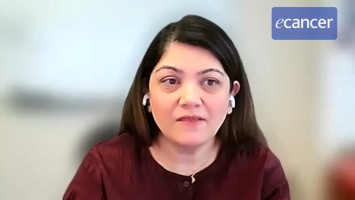We are currently participating in two international phase I trials where we utilise CD33 T-cell recruiting antibody constructs for treatment of relapsed refractory AML. We are pretty advanced in the first trial where we’re utilising CD33 T-cell recruiting antibody constructs that are given as a continuous infusion and we are doing dose steps, seeing some responses, seeing cytokine release but clearly it’s still too early to make a final conclusion. Some of this data was already presented last ASH.
Currently at an earlier time point we are also recruiting patients into a novel trial also in relapsed refractory AML where we are using a half-life extended CD33 BiTE. The same principle, we are also going to go into dose steps. These are still very early, hopefully we’re going to present the first data at ASH this year.
While we are recruiting patients we are very interested in identifying parameters that influence BiTE mediated toxicity or BiTE mediated effectivity in AML. So we have three posters here at EHA which are addressing this subject. The first poster we are looking at the relevance of positive costimulatory and inhibitory checkpoint molecules on primary AML cells for AMG-330 mediated cytotoxicity. What we could clearly show is that the expression of positive costimulatory molecules like CD80 and CD86 have a positive effect on T-cell proliferation and AMG-330 mediated cytotoxicity. However, if you have co-expression of PD-L1, and we have shown previously that through AMG-330 you have secretion of interferon gamma TNF and you have upregulation of PD-L1 on AML cells, you have a dominant negative inhibitory effect. So we are concerned that through the inflammation that is induced through AMG-330 we have an upregulation of a dominant negative inhibitory molecule and therefore we think it might be worth, it might be necessary, to do combinatorial strategies at some point where you add an inhibiting antibody construct that is inhibiting the pathway between PD-1 and PD-L1. But clearly this is only preclinical data but it is suggestive that this might have a role in efficacy and I think it’s an important biomarker to watch while we are conducting the clinical trial.
The second aspect we looked at is if there are serum factors that might influence AMG-330 mediated cytotoxicity. Interestingly, we looked at the serum of bone marrow and peripheral blood of healthy donors and AML patients and also AML patients in remission. We only saw an inhibitory effect in about 50% of the patients with a high infiltration of blasts in the bone marrow. We didn’t observe this in healthy donors and we did not observe this in AML patients in remission. So far we can only show that in about 50% of the patients the serum has a negative impact on T-cell proliferation and on AMG-330 mediated cytotoxicity. So far we can only say that this is a soluble factor because we did transwell experiments and we could show it is not cell-cell contact dependent. So there are other factors, soluble factors, that have a negative impact in patients with a high burden of disease. We are currently doing a mass spec. and other experiments to hopefully identify which factor is contributing negatively on the T-cell function. We also think so far it might imply that utilising these antibody constructs in a situation where you have a low disease burden with a low number of blasts ideally in the MRD setting might be beneficial where we have less immunosuppressive factors.
The third poster we presented is a different BiTE, it’s not CD33 but it’s targeting FLT3 which is a very interesting target antigen because it has a more restricted expression pattern compared to CD33. Here we looked if we can enhance FLT3 BiTE mediated cytotoxicity by adding FLT3 tyrosine kinase inhibitors. What we could show is that there is an additive effect by combining FLT3 BiTE with the tyrosine kinase inhibitor. One of the aspects that is contributing to the additive effect is an upregulation of FLT3 on the surface of primary AML cells. Also we looked at the effect of the tyrosine kinase inhibitors on T-cell function and we could show that in the concentrations we achieve in the serum when we use tyrosine kinase inhibitors in patients we don’t see a negative impact on T-cell proliferation. So we think there might be an additive effect through direct cytotoxicity on the AML cells through upregulation of the target antigen on the AML cells without compromising the T-cell compartment. So we think this is also a very interesting road to follow.








